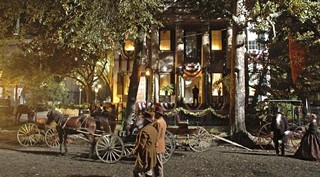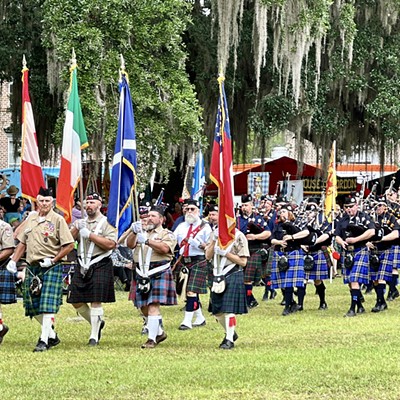Working as an extra in a movie, particularly a big time production like The Conspirator, directed in Savannah by Robert Redford, sounds like a lot of fun. Truth be told, it is.
It’s particularly interesting to watch the set designers transform historic sections of the city into Washington, D.C., which is where the tale is supposed to take place. Seeing the ground floor of a townhouse facing Chatham Square turned into Ford’s Theatre, replete with gas lights, flags and billboards out front, was something to behold.
But be forewarned before rushing out to sign up for the job.
Despite its being filmed in and around several of Savannah’s familiar squares and at Fort Pulaski, moviemaking is not a walk in the park for those filling background scenes as extras. In fact, for the folks portraying Civil War soldiers or “civilian onlookers” wearing period garb, it is countless walks in the park while each scene is repeatedly filmed from every imaginable angle.
Between the walking — done on the command of “background” — there are excruciatingly long periods of standing in place waiting for action of any sort. Since extras are clad in wooly winter attire, most perspire profusely as the sun beats down on them, turning shirts and blouses into a smelly, wet wad of wrinkles which must be donned again, still damp, the next day.
Half way through the day’s effort — and extras generally work 12 hours or more each day — your feet ache because the shoes provided are far too narrow. Apparently moviemakers don’t believe anyone in the 1800s had what is now considered an average width foot. One man said he used a whole roll of tape and gauze to bind his blister–covered feet after a single day’s shooting.
An extra’s work normally starts before daylight and continues until long after dark. Night shoots are the most arduous. Extras report just after 5 p.m. and may still be on the set at 8 the next morning.
I can’t recall being up that long since my college days, and back then I was not on my feet most of that time and what I was doing wouldn’t be called work. This is not to say the actual filming continues constantly over these long hours, since cameras roll only a miniscule part of the time.
Extras report each morning to obtain a sign-in sheet to take to the wardrobe trailer where they stand in a long line to pick up their costume. Then they head for a dressing room where they again stand in line to squeeze into a room filled with a frenzied mob of mostly middle-aged men who curse and hop about in their underwear while trying to maneuver a foot into narrow–legged trousers with button-up flies which are unbelievably cumbersome to open and close.
These buttons make for extended stays in the restroom when one stops to tinkle — a time extended far further should more than a whiz be necessary. If one needs to lower his trousers he must first remove his coat, vest and suspenders before wrestling the buttons on his fly. Once trousers are lowered, an extraordinarily long-tailed shirt must be raised chest-high before any business transpires.
The ordeal sometimes leads one to forego such efforts until approaching a natural disaster.
After finally maneuvering into their costumes, extras must stand in line again for makeup, which turns out to be a misnomer for males. For them, despite the fact that most of their costumes include hats, it consists of getting greasy goo rubbed into their hair — a mess which must be removed each night with a thorough shampooing before it is safe to lower their head onto a pillow.
Female extras get more extended attention with lips, eyes and faces touched up and hairdos meticulously arranged. Why the males receive no such cosmetic attention is hard to imagine, since most of them have blotchy complexions, receding hair lines and sunken eyes surrounded by wrinkles, all of which cry out for attention.
One day when makeup was running late and the line remained long, I was told to bypass the process and head for the set since I looked fine the way I was. This turned out to be a blessing, since from that day on I avoided the makeup line — thus never had to deal with the hair goo again.
No one ever noticed, until the day I was called to the set for a court room scene and the head of the makeup department went spastic when she spotted my gooless hair. She quickly slapped a handful of the stuff on my head, stood back, caught her breath, and exclaimed “there, that’s better!”
Members of the makeup staff, incidentally, are as prolific as bees descending on a field of buttercups.
While each major actor has a special person assigned to meet all his needs — constantly adjusting his outfit, carefully brushing off the smallest speck of lint and fiddling with his hair and makeup — a cadre of others swarms over the extras on the set.
One will adjust your tie and walk away, seemingly satisfied. Then another, with a different opinion, will swoop down, nodding her dismay, and adjust it again, just before another appears to wiggle it around again.
The scenario goes on and on with extras becoming resigned to the unwanted attention and eventually concluding that many of these “artists” are simply striving to be noticed by the directors to justify their positions.
After initially clearing makeup in the morning, extras usually stand around for hours before being called to the set and, once there, stand around another hour or so waiting for the cameras to roll. One day, after going through the lengthy process of getting ready for the shoot, some extras waited until 6 p.m. before being called to the courtroom set for the filming of Mary Surratt’s trial.
On another day several arrived at 7:30 a.m. and wound up lingering in the extras tent until almost 8 p.m. without being called on at all. When not on the set, some spend their time reading or trying to grab a catnap, though most simply stand around chatting.
Several extras utilized breaks in filming to sip vodka which they kept in water bottles stashed in spots near the scenes in which they appeared. These were among the same group that hosted convivial gatherings in their cars after the day’s shoot, prior to their long drive home. One of these whistle-wetters also cozied up to every young hoop skirt-clad female extra at one time or another in hopes of fetching some human comfort following his exhausting theatrical efforts.
A couple of the men regaled a small cadre of listeners with an endless number of off-color stories and seamy scenes on their iPods. A couple of the extras brought along their guitars to provide more wholesome entertainment.
After extras arrive on the set, scenes are first rehearsed without filming, with positions and camera angles reviewed and tweaked for perhaps half an hour before the first film is shot.
Following filming, the scene is reviewed on a monitor, more changes made, and it is shot again, and again, and again.
Once deemed acceptable, cameras are moved to another position and the same scene is rehearsed and then repeatedly shot again in what sometimes seems an interminable session which ultimately results in only a few minutes of “film in the can.”
It’s not the money — minimum wages, with time and a half for overtime in Georgia after an hour is deducted for lunch — which lures most people to sign on as a extra, although I did meet one man at the Fort Pulaski shoot who slept in his car each night and certainly did look like he needed it.
Extras I spoke with said they were doing it for the experience, to expand their list of acquaintances, or just to find out what moviemaking was all about.
A handful, including a couple of SCAD students, hoped they might be “discovered” during the filming and get an early start on a theatrical career. While I am not aware of any such wishes being fulfilled, one or two extras were occasionally pulled to the front of crowd scenes to ensure the cameras would pick them up.
A couple of actor wannabes continually maneuvered themselves into what they thought would be a good camera view following rehearsals only to find actual filming utilized a different angle and their original position would have provided better exposure.
Working as an extra does afford the opportunity to see movie stars up close, and meet interesting folks. I met a prominent Savannah artist who enjoyed tippling with the boys during breaks in the filming; a pharmacist from Hilton Head; a Statesboro construction company owner and the operator of a horse ranch in South Carolina.
One extra was the last teacher at Chatham Junior High School before it closed in the 1970s. Prior to teaching he had been a forest ranger and a world-class bicycle racer. Born in Savannah, his parents had immigrated here to escape persecution in Russia and his father worked for awhile in the old City Market before opening his own business.
One of his uncles was captured by German soldiers before escaping to join the Polish Underground. When the Soviets invaded Poland, he was forced to serve in the Russian Army, which he later deserted, and ultimately worked with U.S. Army Intelligence.
On one sunny day I was positioned beside a young bearded man with whom I walked through a scene for a couple of hours. He turned out to be a Savannah city alderman, Jeff Felser, serving his first day as an extra.
During a break in the filming I told him he would be pleasantly surprised by the quality and variety of the food served each day for lunch. This usually included at least two tasty entrees accompanied by an assortment of delicious vegetables, salads, desserts and lemonade, iced tea and coffee served buffet–style.
Wouldn’t you know, on this day the menu consisted of hamburgers, hot dogs and chili.
Frequently, you get to rub shoulders with the movie stars who occasionally engage you in conversation. Kevin Kline stopped me on the set one day to say my costume was outstanding and chat for a moment.
Stephen Root, an excellent character actor who nailed his lines every time while those about him stumbled, was very personable, chatting at length with several of the extras.
And James MacAvoy stood right behind me for about five minutes while we waited in line to use the urinal. Though the location was somewhat awkward, I managed to get his autograph for one of my nieces.
Redford was particularly gracious on set, taking the time to express his appreciation to extras for their efforts and leading the usual round of applause for stars after they completed a scene. Often, he would lighten the atmosphere on otherwise serious scenes.
He delighted extras with a bit of gallows humor when he discussed nuances of the scene where Mary Surratt and her co–conspirators are hanged, while sitting on the gallows with a hangman’s noose draped around his neck.
Should you decide to try your hand at being a movie extra, following are some tips that may make life easier.
Ducking the makeup ordeal is one of these, although it works best when your costume calls for a hat.
Others are related to the use of restrooms, keeping time, getting a good breakfast, reducing the wait for lunch, getting off your feet, and eliminating the tedium of standing in line at the end of the day to turn in your costume.
Standard restrooms near most of the sets consist of smelly port–a–pottys which are not only distasteful but have no place to hang various parts of your costume. Take the time to scout out better facilities like those provided for tourists at Fort Pulaski. These were well worth the short additional walk.
Wristwatches are forbidden on sets where they don’t match the period, but you’ll find it maddening not to know how long you have been there or when nightfall is approaching on an overcast day. Take the straps off your watch and slip it into a vest pocket or boot to assuage such anguish.
Cameras are also verboten, but bring a small gym bag in which you can stash one and place it near the set since you’ll want photos to recall your experience and regale your friends. No one objected when pictures were taken during filming breaks, particularly at Fort Pulaski where camera-toting tourists converged daily.
It’s also a good idea to bring a book for reading during extended waiting periods, along with gum or breath mints and cigarettes.
A place to sit after hours of standing on the set is often hard to find, hence a comfortable, reclining beach chair can be a Godsend. It can be left just off the set or in the food tent where extras generally linger for hours awaiting their call to the set.
If offered the option, decline to take a proffered prop for your scene. Extended waiting in line to return props such as walking canes, fans and watch chains prior to heading to lunch or after the day’s shoot are standard.
Avoiding them will enable you to get to the head of the line for lunch and wardrobe-changing facilities.
Often, the extras snack table runs out of coffee, but if you scout out the crew’s snack trailer, where coffee is always available, you can grab a cup there when the food preparation staff is not looking.
For some reason they get upset — and let you know it — when you seek a cup from the urn designated for the crew.
After discovering the food served to crew members was generally superior to that provided for extras, some enterprising extras made a habit of slipping into the crew’s buffet for breakfast, passing themselves off as crew members by lining up there before changing into their costumes.
The bottom line is that working as an extra is, as it should be, a fun thing to do. Go for it when moviemakers come to town again.






























